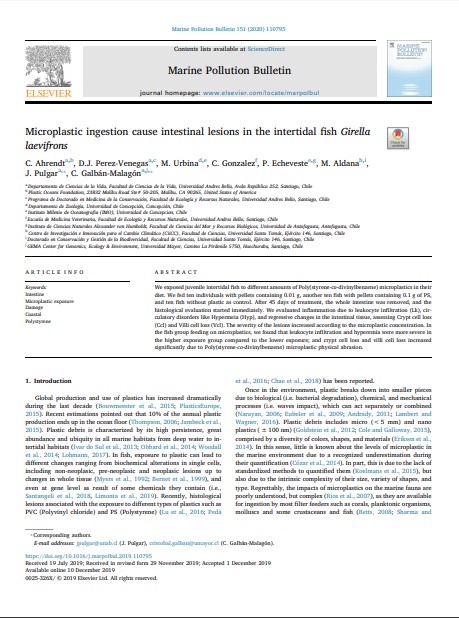Microplastic ingestion cause intestinal lesions in the intertidal fish Girella laevifrons

Fecha
2020Autor
Galban-Malagón, C. [Univ Mayor, GEMA Ctr Genom Ecol & Environm]
Ahrendt, C.
Pérez-Venegas, D. J.
Urbina, M.
González, C.
Echeveste, P.
Aldana, M.
Pulgar, J.
Ubicación geográfica
Notas
HERRAMIENTAS
Acceda a títulos restringidos
¿Cómo descargar?Resumen
We exposed juvenile intertidal fish to different amounts of Poly(styrene-co-divinylbenzene) microplastics in their diet. We fed ten individuals with pellets containing 0.01 g, another ten fish with pellets containing 0.1 g of PS, and ten fish without plastic as control. After 45 days of treatment, the whole intestine was removed, and the histological evaluation started immediately. We evaluated inflammation due to leukocyte infiltration (Lk), circulatory disorders like Hypermeia (Hyp), and regressive changes in the intestinal tissue, assessing Crypt cell loss (Ccl) and Villi cell loss (Vcl). The severity of the lesions increased according to the microplastic concentration. In the fish group feeding on microplastics, we found that leukocyte infiltration and hyperemia were more severe in the higher exposure group compared to the lower exposure; and crypt cell loss and villi cell loss increased significantly due to Poly(styrene-co-divinylbenzene) microplastic physical abrasion.
URI
https://doi.org/10.1016/j.marpolbul.2019.110795http://repositorio.umayor.cl/xmlui/handle/sibum/6477
Coleccion/es a la/s que pertenece:
Si usted es autor(a) de este documento y NO desea que su publicación tenga acceso público en este repositorio, por favor complete el formulario aquí.